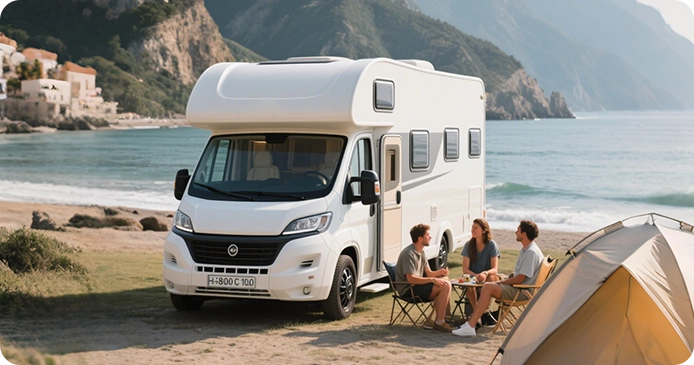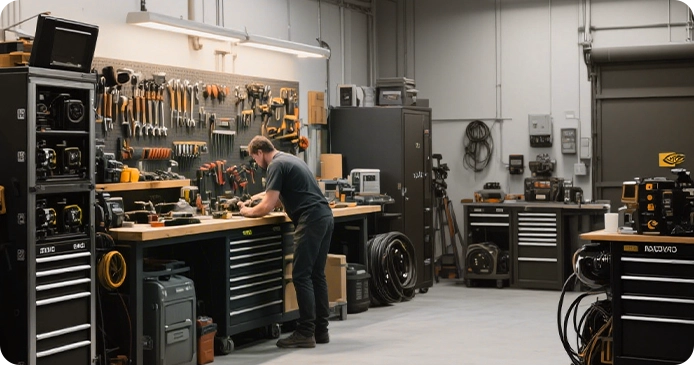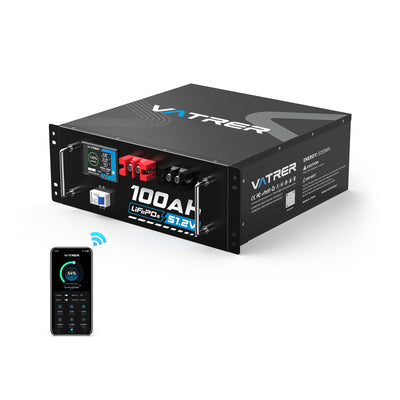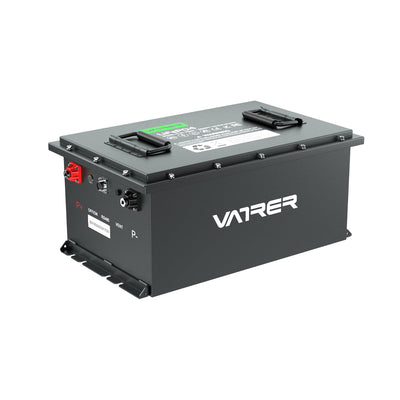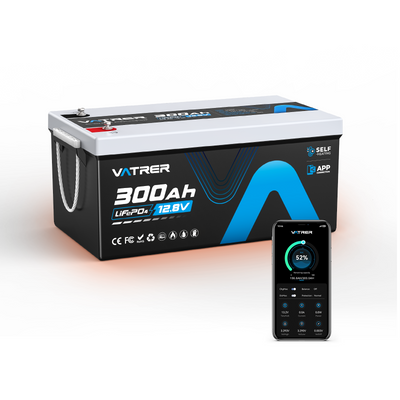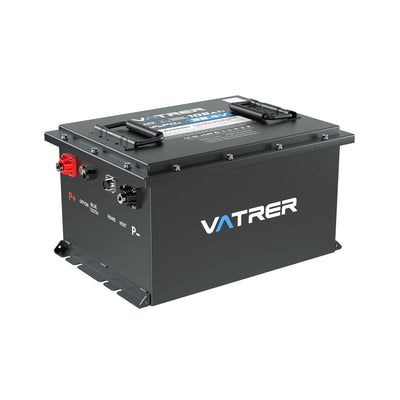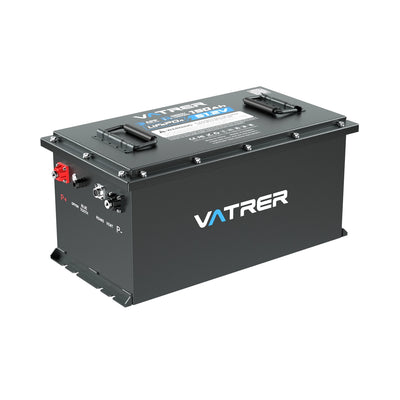
What is an AGM battery?
In the fields of modern vehicles and off-grid systems, reliable and stable power supply is essential. Advances in battery technology have provided more efficient energy solutions for various devices. You may have heard the term “AGM battery” and are wondering: What is an AGM battery? Why is it being widely adopted for power supply? As a valve-regulated sealed lead-acid battery, the AGM battery stands out for its superior performance and maintenance-free characteristics, making it the preferred power source in applications such as automotive start-stop systems, renewable energy storage, and communication equipment.
This article explores the meaning, working principles, advantages and applications of AGM batteries, giving you a comprehensive understanding of AGM batteries and helping you choose the best battery type for you.
What Is An AGM Battery? What Type Of Battery Is It?
AGM battery, the full name of which is absorbed glass fiber separator battery, is a valve-regulated sealed lead-acid battery (VRLA).
This battery technology was born in the late 20th century and was originally developed to meet the needs of aviation and military applications for high-safety, sealed power sources. It was then rapidly expanded to the civilian field due to its excellent performance characteristics. Today, it has become the best battery choice for modern automobile start-stop systems, data center backup power supplies and renewable energy storage.
Although AGM batteries and lead-acid batteries are both types of traditional ordinary batteries, they are still different from standard lead-acid batteries that use free-flowing liquid electrolytes.
AGM batteries use an absorbent separator (AGM separator) woven from ultra-fine glass fibers. This material, with a porosity exceeding 90%, completely wicks the electrolyte within the separator network, eliminating any free liquid electrolyte within the battery. This "lean liquid" design not only eliminates the risk of electrolyte leakage, but also creates ideal conditions for oxygen recombination reactions inside the battery, thus achieving a truly sealed and maintenance-free structure.
The electrolyte of AGM batteries uses a high-purity sulfuric acid aqueous solution, and the density is usually maintained in the range of 1.29-1.31g/cm³, which is slightly higher than the electrolyte density of traditional lead-acid batteries. It is worth noting that the AGM separator deliberately keeps about 10% of the pores unfilled by the electrolyte. These microporous channels provide the necessary path for the oxygen generated by the positive electrode to migrate to the negative electrode, and are the key to achieving internal gas recombination. This sophisticated structural design ensures that the AGM battery loses almost no water during the charge and discharge process, greatly extending its service life.
Compared to conventional lead-acid batteries, AGM batteries represent a significant advancement in battery technology. Traditional flooded batteries require regular checks of the electrolyte level and replenishment of distilled water, while AGM batteries completely eliminate this maintenance requirement through their adsorption structure and special valve control design. Furthermore, their sealing properties significantly expand battery installation flexibility, allowing for sideways mounting and even inverted installation (although prolonged inverted operation is not recommended). This presents a significant advantage in space-constrained applications.

The following table summarizes the main differences between AGM batteries and traditional lead-acid batteries to help you understand more directly:
| Characteristics | AGM battery | Traditional flooded batteries |
|---|---|---|
| Electrolyte status | Adsorbed in a fiberglass separator, lean liquid design | Free electrolyte, flooded design |
| Maintenance requirements | Completely sealed, maintenance-free | Requires regular electrolyte inspection and rehydration |
| Installation position | Can be installed in multiple orientations (avoid long-term inversion) | Usually can only be mounted upright |
| Oxygen recombination efficiency | >95% water loss, virtually no loss | Low pressure, loses water during charging |
| Seismic performance | Excellent resistance to mechanical shock | Generally, prone to plate detachment due to vibration |
What Are The Components Of AGM Batteries? How Does It Work?
To understand how AGM batteries work, we first need to understand their structural design. Their unique construction is the foundation for their high performance and reliability. The core components of this battery include the positive and negative plates, the AGM separator, the electrolyte, the safety valve, and the outer casing. Each component is carefully designed to optimize the battery's overall performance. Below, we will explain in detail the design and role of each component.
- Plate system: It is the key component of AGM battery to realize energy storage and release. Similar to ordinary lead-acid batteries, the active material of the positive plate of AGM batteries is lead dioxide (PbO₂) and the negative plate is spongy lead (Pb), but the plates of AGM batteries usually use purer lead materials and more advanced manufacturing processes, which give them higher energy density and longer cycle life. The grid alloy is also specially formulated to enhance its corrosion resistance and electrical conductivity. And the plates of AGM batteries are thicker and more compact than traditional batteries, which gives the battery better deep cycle performance and physical stability.
- AGM separator: It is woven from ultra-fine glass fibers through a special process to form a three-dimensional network structure with extremely high porosity. This separator not only isolates the positive and negative plates and prevents short circuits, but more importantly, it adsorbs the electrolyte in the fiber network through capillary effect, keeping the sulfuric acid electrolyte in a "non-flowing" state. According to design requirements, the AGM separator will precisely control the adsorption amount of electrolyte, leaving about 10% of the pores unfilled. These tiny pores provide channels for the migration of oxygen between the positive and negative electrodes. The diameter of glass fiber is usually between 1-3 microns. This ultra-fine fiber creates a huge surface area, greatly improving the electrolyte retention capacity and ion conduction efficiency.
- Electrolyte system: Unlike the free-flowing liquid electrolyte in traditional batteries, the electrolyte in AGM batteries is almost entirely adsorbed in the separators and plates, exhibiting "semi-solid" characteristics. This lean electrolyte design not only eliminates the risk of leakage, but also optimizes the contact area between the plates and the electrolyte, reducing internal resistance and enabling the battery to provide greater instantaneous discharge current, which is particularly important for starting and stop systems in vehicles such as golf carts. The amount of electrolyte is precisely calculated to ensure sufficient electrochemical reaction requirements while leaving necessary space for gas diffusion.
- Safety valve: It is an indispensable component of AGM batteries. It uses a precisely designed pressure regulation mechanism to automatically open the exhaust when the internal air pressure exceeds the safety threshold (usually 15-30kPa), preventing the battery shell from being damaged due to overpressure. When pressure returns to normal, the valve reseals, preventing air from entering. This valve-regulated design enables the AGM battery to carry out oxygen circulation reactions internally while ensuring safety and environmental cleanliness.
The following table can help you intuitively understand the main structural components and functions of AGM batteries:
| Structural components | Materials/Properties | Functions |
|---|---|---|
| Positive plate | Lead dioxide (PbO₂) | Positive active material for electrochemical reactions |
| Negative plate | Sponge lead (Pb) | Negative active material for electrochemical reactions |
| AGM separator | Ultrafine glass fiber, porosity >90% | Absorbs electrolyte and provides oxygen diffusion pathway |
| Electrolyte | Aqueous sulfuric acid solution (density 1.29-1.31 g/cm³) | Ionic conductor involved in electrochemical reactions |
| Safety valve | Precision pressure regulator | Controls internal pressure to prevent overpressure or vacuum |
So, with these key structural designs, how does the internal structure of an AGM battery interact and maximize its performance?
During discharge, the lead dioxide at the positive electrode and the spongy lead at the negative electrode react with the sulfuric acid electrolyte to produce lead sulfate and water, a process identical to conventional lead-acid batteries. During charging, the reaction reverses, restoring the original active materials.
However, what makes AGM batteries unique is their oxygen cycle mechanism during the later stages of charging. When charging reaches approximately 70% capacity, oxygen begins to evolve at the positive electrode. This oxygen diffuses through the dry pores reserved in the separator to the negative electrode, where it reacts with the lead at the negative electrode to form lead oxide, which then reacts with sulfuric acid to produce lead and water. This cycle allows the evolved oxygen to be reconstituted into water, virtually eliminating electrolyte loss and ensuring the battery's sealed, maintenance-free nature.
It is worth mentioning that due to the strong adsorption effect of its glass fiber separator on the electrolyte, AGM batteries are not prone to electrolyte concentration drop at low temperatures and are not easy to lose water at high temperatures. Therefore, its operating temperature range is wider than that of traditional batteries, and it can usually maintain good performance between -22°F to +140°F (-30℃ to +60℃). This wide temperature range makes AGM batteries particularly suitable for applications in extreme climates, such as car starting in cold regions or backup power for telecommunication base stations in tropical regions.
What Are The Advantages Of AGM Batteries?
The reason why AGM batteries can gradually replace traditional flooded lead-acid batteries in many application fields is due to their series of performance advantages. These advantages are not only reflected in the basic electrical performance of the battery, but also in multiple characteristics such as safety, environmental adaptability and service life, meeting the increasingly high requirements of modern industry for power equipment.
- Deep Cycle Performance: Compared to ordinary starting lead-acid batteries, AGM batteries use thicker plates and a special active material formula, enabling them to withstand frequent deep discharges (up to 80% DOD) without significantly shortening their lifespan. Traditional starting batteries quickly degrade in performance after deep discharge, but AGM batteries, through their tightly packed plate structure and the support of glass fiber separators, effectively prevent the active material from falling off, greatly extending their cycle life. For example, high-quality AGM start-stop batteries can withstand more than three times the number of deep cycles, which is 3-4 times that of traditional flooded batteries. This feature makes AGM batteries an ideal choice for renewable energy systems (solar energy storage) and auxiliary power sources for electric golf carts.
- High discharge power: Due to the use of ultra-fine glass fiber separators and tight assembly structure, the internal resistance of AGM batteries is lower than that of traditional lead-acid batteries, and they can provide greater instantaneous discharge current. In automotive starting applications, AGM batteries deliver strong cold cranking current (CCA) even in low-temperature environments, ensuring reliable engine starts. Furthermore, low internal resistance reduces energy loss during high-current discharge, improving energy efficiency.
- Fast charging capability: Due to its unique design and electrolyte distribution, AGM batteries can accept higher charging currents without causing plate corrosion or electrolyte stratification. This means that AGM batteries can recover more power than traditional batteries in the same amount of time, which is particularly important for hybrid vehicles with frequent start-stop cycles and rental fleets that require quick turnover.
- Ultra-long float life: This advantage is a key reason why AGM batteries are so popular in backup power applications. In applications such as UPS systems and telecom base stations, where batteries must remain charged for extended periods of time to ensure emergency response, AGM batteries far outperform traditional flooded batteries. This is due to their sealed design and internal oxygen circulation mechanism, which virtually eliminates electrolyte stratification and water loss, the two main factors that affect float life. High-quality AGM batteries have a designed float life of 8-12 years at 77°F (25°C), 1.5-2 times that of ordinary lead-acid batteries. This feature significantly reduces the overall maintenance cost of backup power systems.
- Safety and environmental protection: The sealing design and valve control mechanism of AGM batteries can effectively prevent electrolyte leakage and acid mist escape, eliminating the corrosion and environmental pollution problems common in traditional batteries. Even in the event of accidental overcharging, the safety valve of the AGM battery will open in time to release excess pressure and prevent the shell from rupturing. In addition, AGM batteries have extremely low hydrogen emissions (typically less than 4ml/Ah), well below the safety limits set by international standards, which makes them safe to install near living spaces or in poorly ventilated equipment compartments. From an environmental perspective, AGM batteries have a high lead utilization rate and a sealed structure that reduces the risk of pollution during maintenance, making their impact on the environment relatively small throughout their life cycle.
- Physical stability: The glass fiber separator in AGM batteries not only has excellent electrolyte retention capacity, but also provides excellent mechanical support, making the battery plates less likely to deform or short-circuit under strong vibration or impact. Because there is no free-flowing electrolyte, AGM batteries can be installed in various positions (except for long-term inversion), providing greater layout flexibility for equipment design.
AGM vs. Lead-Acid and Lithium-Ion Batteries
To choose the right battery type, you can compare the core parameters of AGM batteries with those of lead-acid batteries and lithium-ion batteries in the table below, and make a comprehensive assessment based on your own needs.
| Feature | AGM Battery | Flooded Lead-Acid Battery | Lithium-Ion Battery |
|---|---|---|---|
| Maintenance | Maintenance-free | Requires regular water top-ups | Maintenance-free |
| Positioning | Any position (sideways, upside down) | Upright only | Any position |
| Deep Cycling | Excellent (1,000-1,500 cycles) | Limited (~500 cycles) | Superior (2,000-5,000 cycles) |
| Charging Speed | Fast due to low internal resistance | Slower charging | Very fast charging |
| Vibration Resistance | High resistance to vibrations | Moderate, prone to plate damage | High resistance |
| Weight | Moderate (~44-66 lbs (~20-30 kg) for 12V 100Ah) | Heavy (~55-77 lbs (~25-35 kg) for 12V 100Ah) | Lightweight (~22-33 lbs (~10-15 kg) for 12V 100Ah) |
| Lifespan | 4-7 years | 3-5 years | 8-10 years |
| Cost | $150-$400 (varies by size/brand) | $100-$200, most affordable | $300-$1,000, higher upfront cost |
| Energy Density | 30-40 Wh/kg | 25-35 Wh/kg | 100-150 Wh/kg |
What is an AGM battery vs lead acid? Compared to traditional flooded lead-acid batteries, AGM batteries charge faster, offer better resistance to vibrations, and are spill-proof, making them safer and more versatile.
Compared to lithium-ion batteries, AGM batteries are more cost-effective in automotive or marine applications, but they are heavier and have a shorter service life (4-7 years vs. 10-15 years). Lithium-ion batteries have a higher energy density (100-150 Wh/kg vs. 30-40 Wh/kg) and are more suitable for weight-sensitive applications such as electric golf carts or Class A, B, and C motorhomes.
Where Are AGM Batteries Used?
AGM batteries provide reliable power support for various equipment through their deep cycle, high discharge power and high safety characteristics. From the automotive industry to communications systems, from renewable energy to emergency lighting, AGM batteries have a wide range of applications, demonstrating their adaptability and versatility.
Understanding the areas in which AGM batteries are commonly used not only helps you appreciate their practical value but also provides practical advice on selecting a battery for your specific needs.
Vehicle Start-Stop System
With the global automotive industry's increasing demands for energy conservation and emission reduction, more and more vehicles are equipped with intelligent start-stop technology. This system automatically shuts down the engine when the vehicle comes to a temporary stop and quickly restarts it when the driver is ready to move on. This can reduce fuel consumption by 5%-10% in urban driving conditions.
This operating mode places extremely high demands on the battery, requiring it to be able to frequently provide large currents to start the engine and quickly replenish power during short driving intervals.
AGM batteries have deep cycle capabilities, high charge acceptance and anti-vibration characteristics, and can well adapt to the needs of the start-stop system. European high-end car brands such as Mercedes-Benz and BMW have widely adopted AGM batteries as standard equipment in their start-stop systems, and Japanese, Korean, and American automakers are quickly following suit. It should be noted that vehicles equipped with a start-stop system usually require a larger capacity AGM battery, such as 70-100Ah, to cope with frequent starting and increasing on-board electronic loads.
High-end motorcycles and specialty vehicles
Luxury motorcycles, all-terrain vehicles (ATVs), snowmobiles, and high-performance sports cars place stringent demands on batteries for vibration resistance and installation flexibility, precisely where AGM batteries excel. Compared with ordinary lead-acid batteries, AGM batteries can still maintain stable performance under strong vibration and will not fail early due to electrolyte stratification or shedding of active materials on the plates. At the same time, its sealing properties allow batteries to be installed at different angles, providing greater layout freedom in vehicle design.
Renewable Energy Storage Systems
In renewable energy applications such as off-grid solar and small wind power generation, batteries need to store unstable generated energy and output it stably while withstanding frequent charge and discharge cycles. The deep cycle characteristics, low maintenance requirements and good partial state of charge (PSoC) tolerance of AGM batteries make them an ideal choice for small and medium-sized renewable energy systems. Especially for unmanned applications such as solar streetlights and communication relay stations in remote areas, AGM batteries' fully sealed design and lack of water refilling significantly reduce system maintenance costs.
Uninterruptible Power Supplies (UPS) and Telecommunications Backup Power
Critical infrastructure such as data centers, medical equipment, communication base stations, and industrial control systems require continuous and reliable power. In the event of a utility power outage, backup battery systems must immediately take over the load. AGM batteries' long float life, high reliability, and maintenance-free nature make them the preferred choice for these applications. In the telecommunications industry, AGM batteries are widely used for base station backup power. Their compact design allows for greater energy storage within limited space, while their sealed design eliminates the risk of corrosion within the battery compartment. It is worth noting that in these applications, AGM batteries usually work in strings, and their excellent voltage consistency is crucial to extending the overall system life. High-quality AGM batteries can provide 5-10 minutes of emergency power in a UPS system, which is enough to save critical data or start a backup generator.
Marine and RV Power Systems
The marine environment is extremely corrosive to electrical equipment, but the fully sealed structure of AGM batteries effectively resists salt spray corrosion. On yachts and sailboats, AGM batteries are not only used to start the engine, but also provide power for navigation equipment, lighting and onboard electrical appliances. Their anti-vibration characteristics perfectly adapt to the bumpy conditions during ship driving. For RV enthusiasts, AGM batteries are one of the options for powering living facilities in RV battery systems. They can be safely installed in the living area, will not release harmful gases, and can withstand frequent charge and discharge cycles during travel. Some high-end RV power systems even integrate AGM batteries with solar charge controllers to create a completely self-sufficient off-grid power solution.
Electric Vehicles and Industrial Applications
AGM batteries are widely used in electric vehicles such as electric wheelchairs and golf carts due to their deep discharge capability and maintenance-free design. In the medical field, AGM batteries provide reliable power for portable medical devices, emergency lighting, and hospital backup power, and their leak-free nature meets stringent medical safety standards. Security systems, such as alarm devices and emergency lighting, also commonly use AGM batteries to ensure that critical systems can continue to work for hours or even days when the mains power is interrupted.
If you're looking for a high-performance battery, AGM batteries offer a better compromise compared to traditional lead-acid batteries, albeit with a higher initial cost. Their deep-cycle capability and maintenance-free design meet your diverse needs.
If you need to upgrade your RV, electric golf cart, marine electronics, or home solar system, you can also purchase Vatrer 12V, 24V, 36V, and 48V lithium-ion batteries. Our batteries are equipped with a battery management system (BMS), low-temperature protection, and self-heating features. We also offer small-size batteries to suit your installation space. Vatrer batteries offer up to 4,000 deep cycles and zero maintenance, offering excellent value for money.
How to Choose an AGM Battery?
Selecting the right AGM battery for your vehicle, boat, RV, or solar system requires careful evaluation to ensure performance, longevity, and value. What is an AGM battery worth investing in? Below are key factors to consider, each designed to help you make an informed decision tailored to your power needs.
Reserve Capacity and Power Requirements
Reserve capacity measures how long an AGM battery can deliver a steady current before discharging, typically rated in ampere-hours (Ah). For example, a 100Ah battery can theoretically supply 5 amps for 20 hours. When choosing a battery for RV camping or car starting, you need to choose an AGM battery with lower resistance. Because it reduces heat buildup during charging and discharging, thereby improving efficiency and preventing overheating. Please check the battery's reserve capacity specification and make sure it matches your system's power consumption, for example, 50-100Ah for a solar installation and 70-90Ah for a start-stop vehicle.
Lifespan and Usage Patterns
The service life of an AGM battery typically ranges from 4 to 7 years, but this depends on several factors. Frequent deep discharges (below 50% capacity) can shorten lifespan, as can storage in high temperatures (above 77°F/25°C). For instance, an AGM battery in a hot climate or used daily for deep cycling (in an off-grid solar system) may last closer to 4 years, while one used for shallow discharges in a temperate climate may reach 7 years. Check the battery's cycle rating, which indicates how many charge-discharge cycles it can handle (typically 1,000-1,500 cycles at 50% depth of discharge).
Compatibility with Your System
Ensure the AGM battery is compatible with your vehicle or system's electrical requirements, including voltage (commonly 12V for RV and marine use) and amperage. For example, a car with auto start-stop technology requires a battery that supports high discharge rates and frequent cycling, which AGM batteries excel at. Consult your owner's manual or a professional to confirm compatibility, as mismatched batteries can lead to underperformance or damage. Additionally, verify that your charging system (vehicle alternator or solar charge controller) supports AGM technology, as standard battery chargers designed for conventional flooded lead-acid batteries may overcharge or undercharge, reducing service life.
Safety and Certifications
Look for spill-proof AGM batteries, as their sealed design prevents leaks, making them safe for confined spaces like boats or RVs. Certifications such as UL or CE indicate rigorous testing for safety and performance. For example, a UL-certified battery ensures protection against short circuits and thermal runaway.
Cost-Benefit
AGM batteries typically cost between $150 and $400, depending on size, brand, and application. While more expensive than traditional flooded lead-acid batteries ($100-$200), AGM batteries offer long-term savings through their maintenance-free operation and durability. For example, avoiding water top-ups and frequent replacements can save time and money over 4-7 years. Evaluate your budget and usage needs: an AGM battery is cost-effective for high-vibration or deep cycle applications, such as off-road vehicles and boats, but for low-demand uses, a cheaper lead-acid battery might suffice.
If you have enough budget, in addition to AGM batteries, you can also choose Vatrer RV lithium batteries and golf cart lithium batteries. Our batteries comply with international certifications.
How to Maintain Your AGM Battery?
Although AGM batteries are designed to be maintenance-free, proper maintenance can extend their service life, prevent premature failure, and reduce the need for replacement.
- Installation Location: While their sealed structure allows for versatile installation, avoid high-temperature areas such as the engine compartment (ambient temperatures higher than 140°F/60°C accelerate aging). For vehicles with start-stop systems, it is recommended to check the battery's state of health (SOH) every two years or 30,000 kilometers. Use specialized diagnostic equipment to read the internal resistance (normally less than 5 mΩ) and actual capacity (should be greater than 80% of the rated capacity).
- Storage and Maintenance: AGM batteries that are unused for extended periods should be kept fully charged (voltage ≥12.7V) and recharged every three months. Compared to conventional batteries, AGM batteries have a very low self-discharge rate (approximately 3%-5%/month), but this rate may increase in high-temperature environments. It is important to note that AGM batteries must not be opened for water refilling. Water loss during their design life is negligible, and any artificial addition of liquids disrupts the oxygen cycle balance.
Conclusion
A comprehensive understanding of AGM batteries will help you make the most appropriate battery choice based on your needs. Because AGM batteries are more shock-resistant than traditional batteries, and their maintenance-free design makes them a cost-effective power solution for many users.
However, for those seeking a lightweight design and longer lifespan in RVs, golf carts, or home solar systems, lithium batteries are a more attractive option.
Vatrer offers high-performance lithium-ion batteries, such as the 12V 100Ah LiFePO4 battery, which weighs only 24 lbs, making it lighter than the 60 lbs of an AGM battery of the same size, and boasts over 4,000 cycles. Vatrer batteries are ideal for RV, marine, and solar applications, ensuring efficiency and sustainability.
FAQs/People Also Ask
Yes, you can often replace a traditional flooded lead-acid battery with an AGM battery, but compatibility is key. AGM batteries require a charging system that delivers the correct voltage (typically 13.8–14.4V for charging) to avoid overcharging or undercharging.
Check your vehicle's alternator and charging specifications in the owner's manual or consult a mechanic. For example, older vehicles with standard alternators may need a voltage regulator adjustment.
Additionally, ensure the battery's physical size and terminal configuration fit your vehicle's battery compartment. Using an AGM battery in a compatible system can improve performance due to its resistance to vibrations and deep cycle capabilities, but professional installation is recommended to avoid issues.
Yes, AGM batteries are safe for indoor use due to their spill-proof, sealed design, which prevents electrolyte leaks and minimizes hydrogen gas emissions (typically less than 4ml/Ah, well below safety thresholds).
Unlike conventional flooded lead-acid batteries, they don't release acid mist, making them suitable for confined spaces like RV living areas or home solar setups. However, ensure the installation area is a ventilated area to dissipate any minimal gas released during overcharging.
Choose batteries with UL or CE certifications for added safety, and avoid placing them near heat sources (above 140°F/60°C) to prevent thermal stress.
Mixing AGM batteries with traditional flooded lead-acid batteries in the same system is not recommended. AGM batteries have lower internal resistance and different charging requirements (13.8-14.4V) compared to flooded batteries (often 14.4-14.8V).
Mixing them can lead to uneven charging, where one battery type overcharges or undercharges, reducing service life for both. For example, in a solar system with multiple batteries, mismatched charging can cause premature failure.
Use identical AGM batteries in series or parallel configurations, and ensure your battery charger or charge controller is set for AGM settings to maintain performance.
To confirm an AGM battery is fully charged, measure its voltage using a multimeter. A fully charged AGM 12-volt battery should read approximately 12.7-12.9V at rest (not connected to a load or charger) at 77°F (25°C).
If the voltage is below 12.4V, the battery may need charging. Use a battery charger designed for AGM batteries, as it maintains the correct charging profile (constant voltage with a float stage). Avoid overcharging, as voltages above 14.8V can trigger the safety valve, leading to water loss. Regularly check the state of charge, especially during storage, to maintain optimal service life.
If your AGM battery won't hold a charge, first check its voltage (below 12.0V indicates a deep discharge or failure). Attempt to recharge it using an AGM-specific battery charger with a reconditioning mode to address sulfation, a common issue where lead sulfate crystals build up on the lead plates.
If the battery doesn't recover after 24-48 hours of charging, it may be at the end of its service life (typically 4-7 years). Inspect terminals for corrosion and ensure proper connections. If the battery is under warranty (often 1-3 years), contact the manufacturer. Otherwise, replace it with a new AGM battery or lithium battery, ensuring compatibility with your system's discharge rates.
Overcharging an AGM battery with a non-compatible battery charger, such as one designed for conventional flooded lead-acid batteries, can cause excessive gas buildup, triggering the safety valve to release pressure.
This leads to water loss, reducing the electrolyte and shortening the battery's service life. For instance, charging above 14.8V can damage the fiberglass mats and lead plates. To prevent this, use an AGM-specific charger with a voltage limit of 14.4V and a float mode to maintain charge without overstress. Monitor charging regularly, especially in high-demand applications like marine systems, to avoid damage.
AGM batteries perform well in extreme cold (down to -22°F/-30°C) due to their sealed design and strong electrolyte retention by fiberglass mats, which prevents freezing or concentration drops.
However, cold temperatures reduce battery capacity (~20% less at 0°F/-18°C). To optimize performance, keep the battery fully charged (12.7-12.9V) before use, as a discharged battery is more prone to freezing.
For vehicles in cold climates, choose an AGM battery with a high cold cranking amps (CCA) rating (600-800 CCA) to ensure reliable starts. Store unused batteries in a ventilated area above freezing to maintain service life.
To ensure compatibility, check your solar charge controller's settings for AGM battery support, as it must deliver the correct charging profile (typically 13.8-14.4V for absorption and 13.2-13.6V for float).
Most modern controllers (MPPT or PWM models) have adjustable settings for AGM batteries. Verify the battery's voltage (usually 12V for solar systems) and capacity (50-200Ah) align with your system's energy needs. For example, a 100W solar panel paired with a 100Ah AGM battery requires a controller rated for at least 10A. Incorrect settings can reduce service life due to overcharging or undercharging. Consult the controller's manual or a solar technician for setup guidance.
To ensure compatibility, check your solar charge controller's settings for AGM battery support, as it must deliver the correct charging profile (typically 13.8-14.4V for absorption and 13.2-13.6V for float).
It's best to use. AGM batteries are sealed lead-acid (SLA) batteries and are very sensitive to charging voltage and overcharging. Using a smart charger designed specifically for AGM batteries or with an AGM mode can extend battery life and ensure safety.
The voltage of conventional lead-acid battery chargers is often too high (reaching over 14.8V), while the optimal absorption voltage of AGM batteries is approximately 14.4V, and the float charge voltage is approximately 13.2-13.6V. Excessive voltage can cause:
- Battery bulging or increased internal pressure
- Electrolyte drying
- Shortened battery life
Share
1 comment
Do I need to use a battery charger designed for agm batteries?




























